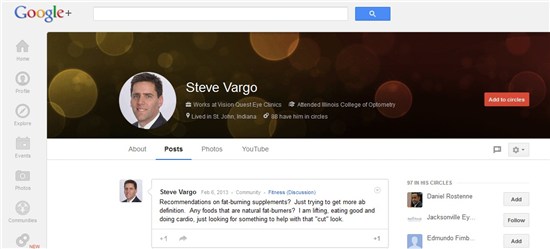By Steve Vargo, OD, MBA 
Use Facebook and other social media to educate patients on eye health and good vision. A simple wellness message keeps your practice top of mind with patients.
Many ODs already make use of social media like Facebook to offer promotions and keep an ongoing conversation with patients. Doing so is invaluable to keep patients thinking about your practice and to encourage them to visit and make a purchase. But there is another use of social media that often is overlooked–the ability to use this platform to educate patients about eye health and vision issues. Here is how you can use social media to give patients information that keeps their eyes in good shape and lets them know why annual visits to an optometrist are important.
 Brand Yourself the
Brand Yourself the
Eye Health and Vision Expert
It is well known that social media is an effective way to help brand a business. For instance, if you are targeting a high-end patient base, you can use social media to feature pictures of an opulent dispensary and advertise upcoming trunk shows, and if you are targeting a value-oriented patient base, you can use social media to promote upcoming sales and dispense coupons. By the same token, you can use your Facebook page to brand yourself as the go-to expert for all eye health and vision-related issues.
Much of the social media marketing that I’ve seen tends to focus on the retail side of optometry, such as coupons and discounts for eyeglasses and contact lenses. While retail marketing can be an effective strategy, an unbalanced approach risks being perceived as overly self-promotional. It also limits the audience to those currently in need of new eyewear. Patients have many eye problems that go beyond simply not seeing well, and they are increasingly using social media to find solutions to their eye health concerns. ODs need to make a concerted effort to create and distribute content that also meets the vast clinical needs of our patients. Brand yourself as the expert, not the salesperson.
Educate on Social Media Why Patients Need You
For example, if you have a blog about eye health such as one featuring commonly asked questions or vision and eye health news, you can feature excerpts of the blog on your Facebook page, or you can simply feature a link to the blog. If you don’t yet have an eye health and vision blog, you can use your social media page as a way to solicit patient eye health and vision questions, and each day or week to include a small description of an eye health or vision issue with a link to your practice web site to read the whole thing. For instance, with spring around the corner, you can post information to your Facebook page on the importance of protecting eyes from ultra-violet radiation mentioning the effects this radiation can have on eyes. In doing so, you can encourage patients to visit to monitor for some of the issues that can arise from UV exposure like macular degeneration and cataracts. You also can mention the products you sell to lessen the chances of such issues arising.
Then Ensure Patients Can Easily Book an Appointment
Social media is a great tool for ultimately driving traffic into your exam chair. If people find your social media content valuable and relevant, and in the process you establish yourself as the eye health and vision expert, they are more likely to seek you out as their eyecare provider. Provide links to your web site or an online appointment request form. Make it easy for people to contact your office to set up an appointment.
Take Education Effort Beyond Facebook
While Facebook is the largest social media platform, Twitter, Google+ and YouTube are also great ways to disseminate educational content to current and prospective patients. If you’re comfortable creating videos, YouTube can be a very effective platform to educate people through visual demonstrations. Videos are also very effective for patient testimonials of eye health success stories. Click HERE to see how Wow Vision Therapy uses YouTube for their specialty vision therapy practice.
Once you create content (blog, articles, video, etc), it’s easy to link to multiple social media accounts to broaden your exposure. Many social media management tools such as HooteSuite allow you to post to multiple sites at once.
If You Haven’t Already, Launch a Practice Blog
Blogs are a great way to educate people on the health of their eyes. In fact, blogs are typically most effective when they provide free content that is interesting, relevant and lacks overt self-promotion. It’s easy to create a blog, and there are many free hosting sites like WordPress and Blogger. Once you’ve published a new blog post, it can be easily linked or posted to your other social media networking sites.
Exercise Care When Responding to Questions on Social Media
Social media is a great tool for engaging and educating patients, but due to HIPAA laws there are boundaries. Doctors must be more vigilant than ever when discussing patient information. I would treat a question posted publicly on social media the same way I would in my office. You wouldn’t discuss specific health information with a patient in the middle of your crowded waiting area. In this case, invite the patient to contact you offline or through a more private or secured patient portal. Most experts agree that over the next few years, technology will continue to adapt to these privacy concerns.
Use Social Media to Educate Patients: Action Plan
Stay professional in messaging. The 80/20 principle is a good guide to follow. Deliver valuable, non-promotional content 80 percent of the time, and reserve the other 20 percent for retail marketing, such as coupons and discounts. In most cases it’s probably best to separate the two, so your efforts to brand yourself as an expert are not muddled by the perception of self-promotion.
Ask yourself what information would your patients find valuable? This starts with listening. For instance, take note of the questions patients e-mail you, and the things they ask you about when in your exam chair. Also think about the misconceptions patients most often possess.
Be engaging and responsive, but don’t violate privacy issues. That means never mentioning by name or any identifying characteristic any patient when answering questions.
Patient testimonials, especially on video, are a powerful and trusted way to educate patients about your services. Always get written permission first, and to maintain the focus on eye health and vision services, seek out patients with eye health success stories they are willing to share publicly.
Make it easy for patients to make an appointment from all of your social media pages. Include a simple “Click here to make an appointment” button on your Facebook page.
Related ROB Articles
Double Your Marketing Impact by Integrating Social Media Messaging
Facebook is Changing. So Should Your Social Media Strategy
A Practice Blog Can Drive Patients to Your Web Site
Steve Vargo, OD, MBA, is president of iMobile Communications in St. John, Ind., a company that specializes in mobile communication and marketing for doctors. Dr. Vargo also is an associate with Vision Quest Eye Clinics in Merrillville, Ind. To contact him:svargo@iMobileCommunications.com.





















